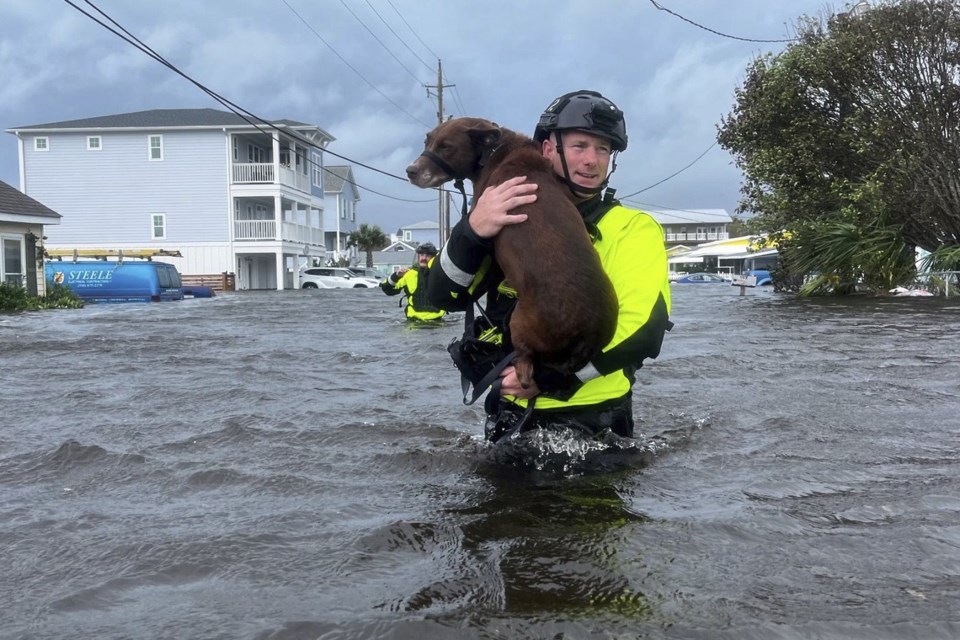The Carolinas braced for a storm that forecasters warned could bring heavy rain — as much as 6 to 8 inches in some spots. But one narrow band got a “firehose” that dumped as much as 20 inches in a so-called 1,000-year flood that shocked many with its intensity.
The storm that left homes flooded, cars submerged and schools closed Tuesday in parts of North Carolina wasn’t really a surprise to scientists who have long said that such rainfalls are one marker of climate change.
“Data shows one of the strongest relationships between climate change and precipitation is that as the atmosphere warms, the capacity to hold water increases. Therefore we see more intense rainfall in a shorter period of time,” said Andrew Kruczkiewicz, senior researcher at the Columbia Climate School at Columbia University.
Monday’s deluge centered on Carolina Beach south of Wilmington, where more than 18 inches (46 centimeters) of rain fell in 12 hours and almost 21 overall. That much rain qualifies as a 1,000-year flood expected only once in that length of time, meteorologists at the National Weather Service office in Wilmington said.
Some areas were hit particularly hard as the storm took a narrow path over the region, “causing a bit of a firehose effect,” NWS meteorologist Lauren Warner said. The agency’s forecasts allowed for “locally higher” amounts, but those weren’t close to what eventually fell.
“If that had moved just a little to the left or continued l the left, that would have mitigated some of the totals that we saw or perhaps spread them out over a wider area,” said Warner. The worst flooding occurred over parts of just two counties, her colleague Tim Armstrong said.
Ocean Isle Beach, just a little over 30 miles (48 kilometers) from Carolina Beach picked up less than 4 inches (10 centimeters) of rain.
Carolina Beach Mayor Lynn Barbee said the 21 inches that fell on his town was impossible to fully prepare for even in a place accustomed to tropical downpours.
“I don’t think I’ve ever seen it rain so hard and for so long,” said Barbee, who has lived on the coast for most of his life. “Not rain bands that get harder and let up or a front moving through. It just sat on top of us.”
The storm system was known as Potential Tropical Cyclone No. 8, but it never organized enough to become the eighth named tropical storm of the season.
The lack of a name added to the difficulty, Barbee said, since people pay more attention to named storms or hurricanes. Tourists were still arriving for beach vacations Monday at the height of the deluge. One family from Pennsylvania lost their van to the floodwaters and are in a shelter instead of their vacation rental, the mayor said.
“We’ve developed a communication dialogue. We communicate cones of uncertainty, expected path, time of arrival, strength on the Saffer-Simpson scale. People know what to expect. But suddenly we’re having storms that don’t fit on these scales,” Barbee said.
Carolina Beach is still cleaning up, and the mayor expects things to be back to normal by the weekend. But town officials are going to keep trying to figure out how to plan for heavy rain like they plan for 18 inches of water to come in from the ocean during a hurricane’s storm surge.
“A foot-and-a-half that falls out of the sky instead of from the ocean -- where does it go?” Barbee said. “We’re finding it in neighborhoods that have never flooded. It’s falling water and not rising water.”
The flash flooding closed dozens of roads in Brunswick County at North Carolina's southeast tip, including U.S. Highway 17, which is the main coastal route. Floodwaters swamped the highway at several points for most of the day, trapping some drivers on high ground that became an island.
Emergency workers brought food and water to people as they waited for the waters to recede, Brunswick County emergency officials said. No deaths were reported but dozens of roads in the county were damaged and many washed out.
Gov. Roy Cooper signed an executive order Tuesday declaring a state of emergency for Brunswick and three other southeastern counties, which the governor said will make additional assistance available for the region.
It wasn't the region's first historic flood by any measure. The same area has seen four other floods of a lifetime in the past 25 years from in 1999, unnamed storms in and , and the benchmark flood with 30 inches of rain from in 2018.
The rain from the system had moved into southeast Virginia on Tuesday. Along North Carolina's Outer Banks, the storm closed vulnerable coastal highway North Carolina 12 on Ocracoke Island and threatened several homes in Rodanthe, where erosion and rising sea levels have destroyed more than a half-dozen beachfront homes this decade.
The Atlantic hurricane season continues through the end of November.
In last month, the National Oceanic and Atmospheric Administration was still predicting a highly active season thanks to near-record sea surface temperatures and the possibility of La Nina. Emergency management officials have urged people to .
Elsewhere in the Atlantic, Gordon as it swirled through open ocean waters. Gordon could either dissolve in upcoming days or strengthen back into a tropical storm, forecasters said.
Jeffrey Collins And Isabella O'malley, The Associated Press



